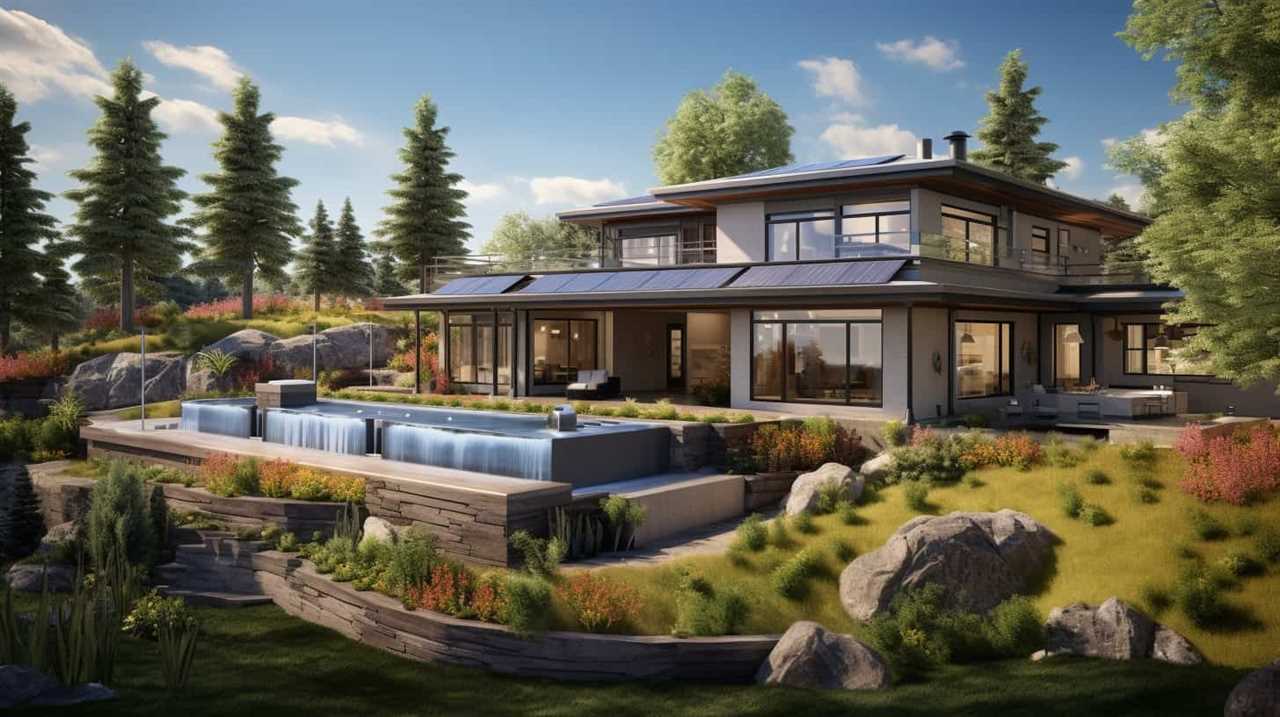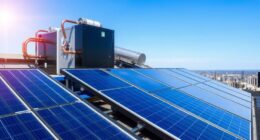We’ve unlocked the secret to harnessing geothermal heat pump technology for commercial use. With our knowledge, you’ll become proficient in deploying these sustainable and effective systems.
From understanding the basics to troubleshooting and maintenance, we’ll guide you through every step. Get ready to optimize performance, save money, and make a positive impact on the planet.
Join us as we delve into the world of commercial geothermal heat pump implementation. Together, we’ll revolutionize the way buildings are heated and cooled.
Key Takeaways
- Geothermal heat pump systems harness the natural heat from the earth for heating and cooling, providing a comfortable indoor environment while minimizing environmental impact.
- Geothermal heat pumps offer significant energy savings and environmental benefits for commercial buildings, reducing energy consumption and carbon emissions.
- While upfront installation costs may be higher, geothermal heat pumps can lead to long-term cost savings through reduced energy bills and lower maintenance requirements.
- Proper sizing, design, and installation considerations, along with regular maintenance and system monitoring, are essential for efficient operation and maximum energy savings.
Understanding the Basics of Geothermal Heat Pump Systems
We will now delve into the fundamentals of geothermal heat pump systems.

Geothermal heat pumps are an incredible technology that harnesses the natural heat from the earth to provide efficient heating and cooling for our buildings.
These systems work by transferring heat between the ground and the building, using a series of pipes buried underground.
The earth’s constant temperature acts as a source of heat during the winter and a heat sink during the summer.
This method of heating and cooling not only saves energy but also reduces greenhouse gas emissions.

With a geothermal heat pump system, we can enjoy a comfortable indoor environment while minimizing our impact on the environment.
It’s a win-win situation!
Assessing the Viability of Geothermal Heat Pump Technology for Commercial Buildings
When considering the viability of geothermal heat pump technology for commercial buildings, there are several key points to assess.
Firstly, the energy efficiency benefits must be evaluated, as these systems have the potential to significantly reduce energy consumption and greenhouse gas emissions.

Secondly, cost considerations should be taken into account, including upfront installation costs, ongoing maintenance expenses, and potential long-term savings.
Lastly, it’s important to acknowledge the installation challenges that may arise, such as site suitability, drilling requirements, and system integration with existing infrastructure.
Energy Efficiency Benefits
Assessing the viability of geothermal heat pump technology for commercial buildings, we can determine the energy efficiency benefits it offers. Geothermal heat pumps are an excellent choice for improving energy efficiency in commercial buildings due to the following reasons:
- Significant reduction in energy consumption and carbon emissions.
- Enhanced comfort and indoor air quality.
- Long lifespan and low maintenance requirements.
- Use of renewable energy sources, reducing reliance on fossil fuels.
- Potential for cost savings through lower energy bills.
Implementing geothermal heat pump technology can lead to substantial energy savings and environmental benefits for commercial buildings. By utilizing the earth’s natural heat, these systems provide efficient heating and cooling solutions while minimizing the negative impact on the environment.

Now, let’s explore the cost considerations associated with geothermal heat pump implementation.
Cost Considerations
As we delve into the topic of cost considerations, it’s crucial for us to assess the viability of geothermal heat pump technology for commercial buildings.
When it comes to implementing geothermal heat pumps, one of the main concerns is the upfront cost. While it’s true that the initial investment may be higher compared to traditional heating and cooling systems, it’s important to consider the long-term benefits.
Geothermal heat pumps have the potential to significantly reduce energy consumption and operational costs, leading to substantial savings over time. Additionally, there are various financial incentives, such as tax credits and rebates, available to offset the initial investment.

Furthermore, geothermal systems require less maintenance and have a longer lifespan, further contributing to cost savings.
Installation Challenges
We encountered several challenges during the installation of geothermal heat pump technology in commercial buildings, but we were able to assess its viability successfully.
These challenges included:
Limited space for drilling boreholes: In some urban areas, finding enough space for drilling boreholes can be a challenge, as there may be underground utility lines or other obstacles.

High upfront costs: The initial investment required for installing geothermal heat pump systems can be substantial, which can be a barrier for some commercial building owners.
Retrofitting existing buildings: Retrofitting existing buildings with geothermal heat pump technology can be more complicated than installing it in new constructions.
System complexity: Geothermal heat pump systems require careful design and installation to ensure optimal performance and efficiency.
Environmental considerations: Assessing the environmental impact of drilling and groundwater usage is crucial to ensure the sustainability of geothermal heat pump technology.

Despite these challenges, our successful assessment of the viability of geothermal heat pump technology in commercial buildings demonstrates its potential for significant energy savings and environmental benefits.
Sizing and Design Considerations for Commercial Geothermal Heat Pump Systems
When it comes to sizing and designing commercial geothermal heat pump systems, there are several key considerations to keep in mind.
Optimal system sizing is crucial to ensure efficient operation and maximum energy savings.
Design efficiency factors such as heat load calculations, thermal conductivity of the ground, and heat exchanger design must also be taken into account.

Additionally, the geothermal heat source, whether it be a vertical or horizontal loop system, plays a significant role in determining the system’s performance and overall effectiveness.
Optimal System Sizing
Our team focuses on determining the optimal system size for commercial geothermal heat pump systems. When it comes to sizing these systems, there are several important factors to consider:
Building size and layout: Understanding the square footage and layout of the building is crucial for determining the appropriate system size.
Heating and cooling loads: Calculating the heating and cooling loads of the building helps us determine the capacity requirements of the geothermal heat pump system.

Climate conditions: The climate in which the building is located plays a significant role in sizing the system as it affects the energy requirements for heating and cooling.
Occupancy patterns: Knowing the occupancy patterns of the building helps us determine the load variations throughout the day, which influences the sizing of the system.
Future expansion: Considering any future expansion plans for the building is essential to ensure the system can accommodate increased load demands.
By taking these factors into account, we can determine the optimal system size that will provide efficient and effective heating and cooling for commercial geothermal heat pump systems.

Now, let’s delve into the next section, where we’ll discuss the design efficiency factors.
Design Efficiency Factors
Taking into account the building’s size and layout, as well as the heating and cooling loads, climate conditions, occupancy patterns, and future expansion plans, our team focuses on determining the optimal system size for commercial geothermal heat pump systems.
By considering these design efficiency factors, we ensure that the geothermal heat pump system is specifically tailored to meet the unique needs of each commercial building. Our intimate understanding of these factors allows us to create a system that maximizes energy efficiency, reduces operating costs, and provides optimal comfort for building occupants.
We carefully analyze the building’s thermal characteristics, including insulation levels, window orientation, and air infiltration rates, to accurately calculate the heating and cooling loads. This attention to detail ensures that the system is correctly sized and designed, resulting in a highly efficient and effective geothermal heat pump system.

Geothermal Heat Source
To ensure an optimal design for commercial geothermal heat pump systems, we carefully consider the sizing and design considerations of the geothermal heat source. This is a crucial step in maximizing the efficiency and performance of the system. Here are five key factors to consider:
Site Evaluation: We assess the geological features of the site to determine the suitability of the ground for heat exchange. Factors such as soil type, water table depth, and rock formations play a significant role.
Heat Load Calculation: Accurately determining the building’s heating and cooling demands helps us size the geothermal heat source appropriately. This ensures efficient operation and prevents under or over-sizing.
Ground Loop Design: We design the underground loop system to efficiently capture and transfer heat. Factors such as loop configuration, pipe sizing, and depth are carefully considered.

Flow Rate and Temperature Differential: Optimizing these variables ensures proper heat transfer between the ground and the heat pump system.
Environmental Impact: We take into account the environmental impact of the geothermal heat source, ensuring compliance with regulations and minimizing disruption to the site.
Selecting the Right Equipment and Components for Your Geothermal Heat Pump System
We need to carefully select the right equipment and components for our geothermal heat pump system. Choosing the appropriate equipment and components is crucial for maximizing the efficiency and performance of the system. Here is a table that outlines the key components and their functions:
| Component | Function |
|---|---|
| Heat Pump | Transfers heat between the ground and the building |
| Ground Loop | Circulates the heat transfer fluid underground |
| Heat Exchanger | Transfers heat between the ground loop and the heat pump |
| Distribution System | Distributes the heated or cooled air throughout the building |
Each component plays a vital role in the operation of the geothermal heat pump system. It is important to consider factors such as the size and capacity of the heat pump, the length and configuration of the ground loop, and the efficiency of the heat exchanger. By carefully selecting the right equipment and components, we can ensure optimal performance and energy savings for our geothermal heat pump system.

Implementing Proper Installation Practices for Commercial Geothermal Heat Pumps
First, we’ll ensure that the installation of commercial geothermal heat pumps is done properly. This step is crucial for maximizing the efficiency and longevity of your system. To achieve this, we recommend the following practices:
- Proper sizing: Ensuring that the heat pump is correctly sized for the building’s heating and cooling demands.
- Site evaluation: Conducting a thorough evaluation of the site to determine the best location for the heat pump installation.
- Vertical vs. horizontal loops: Choosing the appropriate loop design based on available space and soil conditions.
- Loop placement: Carefully placing the loops to minimize interference with other underground utilities and maximize heat transfer.
- Quality control: Regularly inspecting the installation process to ensure that all components are properly connected and functioning.
Optimizing Performance and Efficiency of Geothermal Heat Pump Systems in Commercial Buildings
We can enhance the performance and efficiency of geothermal heat pump systems in commercial buildings by implementing strategic maintenance and operational practices.
By regularly conducting maintenance checks and inspections, we ensure that the system is running at its optimal capacity. This includes cleaning and replacing filters, checking for leaks, and monitoring the overall performance of the system.
Additionally, implementing proper operational practices can greatly improve efficiency. This includes adjusting temperature setpoints, optimizing system controls, and utilizing energy-saving features.

By closely monitoring and fine-tuning the system, we can ensure that it operates at its highest efficiency, resulting in significant energy savings and lower operating costs.
Furthermore, educating building occupants about energy-saving practices and encouraging their participation can also contribute to improving the performance and efficiency of the geothermal heat pump system.
Maintaining and Troubleshooting Geothermal Heat Pump Systems in Commercial Settings
Regular maintenance and effective troubleshooting are essential for ensuring the proper functioning of geothermal heat pump systems in commercial settings. Neglecting these tasks can lead to decreased performance, higher energy consumption, and costly repairs.
To help you maintain and troubleshoot your geothermal heat pump system, here are five important tips:

- Schedule regular maintenance checks with a qualified technician to inspect and clean the system components.
- Monitor the system’s performance and energy consumption to identify any anomalies or inefficiencies.
- Keep the heat pump’s filters clean and replace them as recommended by the manufacturer.
- Check the fluid levels and pressure regularly to ensure optimal heat transfer.
- Familiarize yourself with the system’s control panel and settings to troubleshoot minor issues and make necessary adjustments.
Exploring Incentives and Financing Options for Commercial Geothermal Heat Pump Projects
When exploring incentives and financing options for commercial geothermal heat pump projects, we can find a range of opportunities to help offset costs and make the implementation more financially feasible. There are various incentives and grants available at the federal, state, and local levels that can significantly reduce the upfront costs of installing a geothermal heat pump system. These incentives can include tax credits, rebates, and low-interest loans.
Additionally, some utility companies offer special programs and financing options specifically for geothermal projects. These incentives not only make the initial investment more affordable but also help to reduce the payback period, making geothermal heat pump systems even more attractive for commercial applications.
Transitioning into the next section, let’s now explore some case studies of successful commercial implementations of geothermal heat pump technology.
Case Studies: Successful Commercial Implementations of Geothermal Heat Pump Technology
To illustrate successful commercial implementations of geothermal heat pump technology, let’s examine some case studies. These real-life examples highlight how businesses have harnessed the power of geothermal heat pump systems to achieve their heating and cooling needs. Here are five remarkable success stories:

ACME Office Building: Reduced energy consumption by 40% and achieved a 3-year payback period.
GreenTech Manufacturing: Cut carbon emissions by 50% and saved $100,000 annually in energy costs.
EcoHotel: Achieved LEED Platinum certification while reducing energy bills by 30%.
City Community Center: Lowered heating and cooling expenses by 35% and saw a return on investment in just 5 years.

Supermarket Chain: Saved over $200,000 annually in energy costs and significantly reduced their carbon footprint.
These case studies demonstrate the tangible benefits and long-term cost savings that can be realized through the implementation of geothermal heat pump technology.
Frequently Asked Questions
Can Geothermal Heat Pumps Be Used in Residential Buildings as Well?
Yes, geothermal heat pumps can also be used in residential buildings. They are a sustainable and efficient way to heat and cool homes, providing energy savings and reducing carbon emissions.
What Are the Typical Maintenance Requirements for Geothermal Heat Pump Systems?
We’ve found that regular maintenance for geothermal heat pump systems typically includes checking and cleaning filters, inspecting the heat exchanger, and ensuring the system is operating efficiently. It’s important to schedule professional maintenance to keep the system running smoothly.

Are There Any Government Incentives Available for Commercial Geothermal Heat Pump Projects?
Yes, there are government incentives available for commercial geothermal heat pump projects. These incentives can help offset the initial costs and make implementing such projects more financially feasible for businesses.
How Long Does It Usually Take to Recoup the Initial Investment in a Commercial Geothermal Heat Pump System?
On average, we recoup our initial investment in a commercial geothermal heat pump system within 5-10 years. It’s like planting a money tree that keeps growing – a smart and profitable long-term investment.
What Are the Potential Challenges or Limitations of Implementing Geothermal Heat Pump Technology in a Commercial Building?
Implementing geothermal heat pump technology in a commercial building can present challenges such as high upfront costs, site limitations, and the need for specialized expertise. However, with proper planning and support, these obstacles can be overcome to achieve efficient and sustainable heating and cooling solutions.
Are the Strategies for Geothermal Heat Pump Maintenance Applicable to Commercial Implementation as Well?
Geothermal heat pump maintenance strategies play a vital role in ensuring the optimal performance and longevity of these systems. But are these strategies applicable to commercial implementation as well? Absolutely. The same principles of regular inspections, filter replacement, and ensuring proper airflow apply to both residential and commercial geothermal heat pump systems. By following these maintenance strategies, businesses can maximize the efficiency and reliability of their commercial geothermal system, contributing to long-term cost savings and comfort.
Conclusion
In conclusion, mastering the implementation of geothermal heat pump systems in commercial buildings requires several key considerations:

Thorough understanding of the technology: It is essential to have a deep understanding of how geothermal heat pump systems work, including the principles of heat transfer and the different components involved.
Viability assessment: Before implementing a geothermal heat pump system, a thorough assessment of the site’s geology, hydrology, and thermal characteristics is necessary to determine if it is suitable for this technology.
Proper sizing and design considerations: The system must be properly sized to meet the heating and cooling demands of the building. Factors such as building size, insulation, and desired indoor comfort levels should be considered during the design phase.
Equipment selection: Choosing the right equipment is crucial for the system’s performance and efficiency. This includes selecting the appropriate heat pump unit, ground loop system, and controls.

Proper installation practices: The installation of a geothermal heat pump system requires skilled professionals who follow industry best practices. Proper installation ensures optimal system performance and longevity.
Performance optimization: Regular maintenance and optimization of the system are necessary to ensure its efficiency and effectiveness. This includes monitoring and adjusting controls, checking for leaks, and cleaning components.
Troubleshooting and maintenance: Inevitably, issues may arise with the system. Having a plan in place for troubleshooting and maintenance is crucial to quickly address any problems and minimize downtime.
By exploring incentives and financing options, businesses can successfully implement geothermal heat pump technology and contribute to a more sustainable future. Taking advantage of government incentives and financing programs can help offset the initial costs and make geothermal heat pump systems more affordable for businesses.










